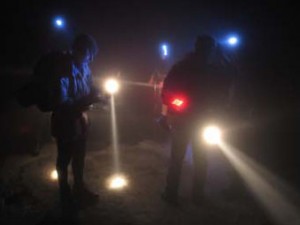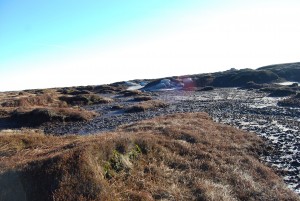Strike a light! Carry a torch.
Winter will suddenly make its presence felt when the clocks go back in the early hours of Sunday 31st October. Officially sunset drops  back one hour from 5.38 pm on Saturday evening to 4.36 pm on Sunday evening. It’s an hour that makes a world of difference to walkers coming off the upper slopes of the peak-land hills, and every year it catches someone out.
back one hour from 5.38 pm on Saturday evening to 4.36 pm on Sunday evening. It’s an hour that makes a world of difference to walkers coming off the upper slopes of the peak-land hills, and every year it catches someone out.
The clock change usually results in a spate off call-outs for local rescue teams assisting people who get caught out by the shorter days and early nightfalls. The moors can be a lonely, frightening place in the dark – especially for the unprepared walker without a torch. With better planning you can avoid the situation, but, if you are late, then a headlight or torch is an essential piece of equipment that should be in everyone’s rucksack.
Descending from the hills is always the most dangerous part of the day, to attempt it in the dark without a lamp is inviting trouble. Modern L.E.D. lamps weigh almost nothing and last hours on one set of batteries. There’s no reason not to carry one all year round, but in winter they can be a life saver.
Advice from the rescue team:
Plan ahead, check sunset times, and consider the effect of bad weather. Always carry a lamp, preferably two, as its easier to swap lamps than to change batteries in the dark. Always check that they are working before you set off. Everyone in the group should have their own lamp, including children. At the onset of darkness, stop and plot your exact position whilst you can still see landmarks, and pay keen attention to your navigation. In poor or no light, pick less steep routes without hidden crags, and never follow a water course.
If you are unprepared and ill-equipped you may be in for a long, cold and frightening night.  Rescue teams will come to your assistance if called but you will seriously disturb thirty or more voluntary members from their evening with family or friends. You will cause them the expense of traveling to the incident, and place them at risk of personal injury whilst climbing to your aid. Scarce police resources will be diverted from other tasks, and a helicopter flying over high ground at night will disturb local residents and livestock. A search operation consumes many hours of volunteers’ time and costs hundreds of pounds of public and charity money. Please carry a working torch!
Rescue teams will come to your assistance if called but you will seriously disturb thirty or more voluntary members from their evening with family or friends. You will cause them the expense of traveling to the incident, and place them at risk of personal injury whilst climbing to your aid. Scarce police resources will be diverted from other tasks, and a helicopter flying over high ground at night will disturb local residents and livestock. A search operation consumes many hours of volunteers’ time and costs hundreds of pounds of public and charity money. Please carry a working torch!
If, as a last resort, you do call for assistance, establish your position. Try to get to a recognisable landmark like a cairn, trig point, stream, or wall junction. Simple things can be helpful: have you walked on any paved footpaths, crossed any stiles or bridges? What is the direction of water flowing in nearby streams? If you can see the lights of a village in the valley, check the wind direction on your face. Of course, to do that you need a compass, and if you haven’t got a torch, you probably won’t have a compass either. Should you really be there in the first place?
Keep you party sheltered and warm using any extra clothing and food and that emergency shelter or bivi-bag you always carry. Of course, if you haven’t got a torch or a compass then you probably don’t have spare clothing or food either. Should you really be there in the first place?
If in genuine trouble, make that call. Dial 999 for the police stating clearly that you need mountain rescue. You need to stay in a position with a good phone signal because someone from the rescue team will ring you back to ask you lots of embarrassing questions.
Do not be afraid to call. It may be that some advice over the phone is all that is required. If you are in real danger, then the rescue teams are there to assist – and they would rather be called early than too late! All they ask is that you try to avoid the situation in the first place with a little sensible planning.
If a rescue team is dispatched to help you, it is essential you keep together in one place. DO NOT TRY TO WALK OFF THE HILL unless instructed to do so.The police will try to triangulate your phone signal which can indicate where the rescue teams are best deployed. A methodical search plan becomes impossible when looking for a moving target. You will have to be patient: it may take an hour for teams to assemble, another hour or more to climb onto the moor – and that’s if we know where you are!
Search dogs will be the first rescue units deployed so keep watching and listening for their approach. Try to attract their attention with any light you have; a cigarette lighter or mobile phone display. Make plenty of noise and blow your emergency whistle – but if you haven’t got a torch or a compass or extra ………………., oh, never mind!
If you have taken the trouble to read to the end of this article, it probably wasn’t aimed at you in the first place. But thanks anyway!
Photos: middle: Kinder by day. Bottom: Kinder by night!